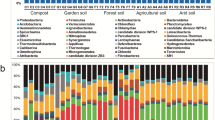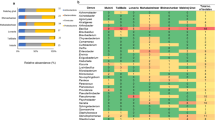Abstract
Coniferous forest soils have an indispensable ecological role in the global cycles of nutrients on Earth. Despite the fact that microbial communities in this ecosystem were subject of multiple studies, the involvement of individual taxa in the processes of organic matter transformation and the functional roles of dominant and active bacteria are largely unknown. Here, we have performed a comprehensive isolation effort to obtain multiple dominant bacterial taxa from a Picea abies forest soil and provide their physiological characterization. This information allows us to link ecological traits with groups of microorganisms. In the study, conventional culture techniques at acidic pH and low-nutrient content led to the recovery of 299 bacterial isolates. The isolates represented operational taxonomic units (OTUs) that contained 20 and 32 % of all bacterial genomes detected in the litter and soil by 16S amplicon analysis, including some of those bacterial strains representing the most abundant and active OTUs. These included also several isolates of the still underexplored phylum of the Acidobacteria, all of them belonging to the subdivision 1 of the phylum. Acidobacterial isolates produced the widest range of enzymes among all isolates and highest enzyme activities in acidic conditions. Moreover, members of the Acidobacteria represented more than 50 % of the isolates able to grow on disaccharides produced during the breakdown of cellulose, chitin, and starch. Our results indicate that Acidobacteria may play an important ecological role by degrading polysaccharides of plant and fungal origin in the important ecosystems of acidic coniferous forests.


Similar content being viewed by others
References
Altschul SF, Madden TL, Schaffer AA, Zhang J, Zhang Z, Miller W, Lipman DJ (1997) Gapped BLAST and PSI-BLAST: a new generation of protein database search programs. Nucleic Acids Res 25:3389–3402
Baldrian P (2009) Microbial enzyme-catalyzed processes in soils and their analysis. Plant Soil Environ 55:370–378
Baldrian P, Kolařík M, Štursová M, Kopecký J, Valášková V, Větrovský T, Žifčáková L, Šnajdr J, Rídl J, Vlček C, Voříšková J (2012) Active and total microbial communities in forest soil are largely different and highly stratified during decomposition. ISME J 6:248–258
Berlemont R, Martiny AC (2013) Phylogenetic distribution of potential cellulases in bacteria. Appl Environ Microbiol 79:1545–1554
Berlemont R, Martiny AC (2015) Genomic potential for polysaccharide deconstruction in bacteria. Appl Environ Microbiol 81:1513–1519
Caporaso JG, Lauber CL, Walters WA, Berg-Lions D, Huntley J, Fierer N, Owens SM, Betley J, Fraser L, Bauer M, Gormley N, Gilbert JA, Smith G, Knight R (2012) Ultra-high-throughput microbial community analysis on the Illumina HiSeq and MiSeq platforms. ISME J 6:1621–1624
Cole JR, Wang Q, Fish JA, Chai B, McGarrell DM, Sun Y, Brown CT, Porras-Alfaro A, Kuske CR, Tiedje JM (2014) Ribosomal Database Project: data and tools for high throughput rRNA analysis. Nucleic Acids Res 42:633–642
Davis KER, Joseph SJ, Janssen PH (2005) Effects of growth medium, inoculum size, and incubation time on culturability and isolation of soil bacteria. Appl Environ Microbiol 71:826–834
de Boer W, Folman LB, Summerbell RC, Boddy L (2005) Living in a fungal world: impact of fungi on soil bacterial niche development. FEMS Microbiol Rev 29:795–811
Dowd SE, Callaway TR, Wolcott RD, Sun Y, McKeehan T, Hagevoort RG, Edrington TS (2008) Evaluation of the bacterial diversity in the feces of cattle using 16S rDNA bacterial tag-encoded FLX amplicon pyrosequencing (bTEFAP). BMC Microbiol 8:125
Eichorst SA, Kuske CR (2012) Identification of cellulose-responsive bacterial and fungal communities in geographically and edaphically different soils by using stable isotope probing. Appl Environ Microbiol 78:2316–2327
Eichorst SA, Breznak JA, Schmidt TM (2007) Isolation and characterization of soil bacteria that define Terriglobus gen. nov., in the phylum Acidobacteria. Appl Environ Microbiol 73:2708–2717
Elsas JD, Jansson JK, Trevors JT (2007) Modern soil microbiology, 2nd edn. CRC Press/Taylor & Francis, Boca Raton, FL, 646 pp
Fontaine S, Mariotti A, Abbadie L (2003) The priming effect of organic matter: a question of microbial competition? Soil Biol Biochem 35:837–843
George IF, Hartmann M, Liles MR, Agathos SN (2011) Recovery of as-yet-uncultured soil Acidobacteria on dilute solid media. Appl Environ Microbiol 77:8184–8188
Gessner MO, Swan CM, Dang CK, Mckie BG, Bardgett RD, Wall DH, Hattenschwiler S (2010) Diversity meets decomposition. Trends Ecol Evol 25:372–380
Haichar FZ, Achouak W, Christen R, Heulin T, Marol C, Marais M, Mougel C, Ranjard L, Balesdent J, Berge O (2007) Identification of cellulolytic bacteria in soil by stable isotope probing. Environ Microbiol 9:625–634
Hartmann M, Howes CG, VanInsberghe D, Yu H, Bachar D, Christen R, Nilsson RH, Hallam SJ, Mohn WW (2012) Significant and persistent impact of timber harvesting on soil microbial communities in northern coniferous forests. ISME J 6:2199–2218
Janssen PH, Yates PS, Grinton BE, Taylor PM, Sait M (2002) Improved culturability of soil bacteria and isolation in pure culture of novel members of the divisions Acidobacteria, Actinobacteria, Proteobacteria, and Verrucomicrobia. Appl Environ Microbiol 68:2391–2396
Langille MGI, Zaneveld J, Caporaso JG, McDonald D, Knights D, a Reyes J, Clemente JC, Burkepile DE, Vega Thurber RL, Knight R, Beiko RG, Huttenhower C (2013) Predictive functional profiling of microbial communities using 16S rRNA marker gene sequences. Nat Biotechnol 31:814–821
Lauro MF, McDougald D, Thomas T, Williams TJ, Egan S, Rice S, DeMaere MZ et al (2009) The genomic basis of trophic strategy in marine bacteria. PNAS 106:15527–15533
Lin YT, Lin CP, Chaw SM, Whitman WB, Coleman DC, Chiu CY (2010) Bacterial community of very wet and acidic subalpine forest and fire-induced grassland soils. Plant Soil 332:417–427
López-Mondéjar R, Voříšková J, Větrovský T, Baldrian P (2015) The bacterial community inhabiting temperate deciduous forests is vertically stratified and undergoes seasonal dynamics. Soil Biol Biochem 87:43–50
Meyer F, Paarmann D, D’Souza M, Olson R, Glass E, Kubal M et al (2008) The metagenomics RAST server—a public resource for the automatic phylogenetic and functional analysis of metagenomes. BMC Bioinf 9:386
Myneni RB, Dong J, Tucker CJ, Kaufmann RK, Kauppi PE, Liski J, Zhou L, Alexeyev V, Hughes MK (2001) A large carbon sink in the woody biomass of northern forests. PNAS 98:14784–14789
Nacke H, Thurmer A, Wollherr A, Will C, Hodac L, Herold N, Schoning I, Schrumpf M, Daniel R (2011) Pyrosequencing-based assessment of bacterial community structure along different management types in German forest and grassland soils. Plos One 6:e17000
Nannipieri P, Giagnoni L, Renella G, Puglisi E, Ceccanti B, Masciandaro G, Fornasier F, Moscatelli MC, Marinari S (2012) Soil enzimology: classical and molecular approaches. Biol Fertil Soils 48:743–762
Nielsen UN, Ayres E, Wall DH, Bardgett RD (2011) Soil biodiversity and carbon cycling: a review and synthesis of studies examining diversity-function relationships. Eur J Soil Sci 62:105–116
Pankratov TA, Ivanova AO, Dedysh SN, Liesack W (2011) Bacterial populations and environmental factors controlling cellulose degradation in an acidic Sphagnum peat. Environ Microbiol 13:1800–1814
Rawat SR, Männistö MK, Bromberg Y, Häggblom MM (2012) Comparative genomic and physiological analysis provides insights into the role of Acidobacteria in organic carbon utilization in Arctic tundra soils. FEMS Microbiol Ecol 82:341–355
Sagova-Mareckova M, Cermak L, Novotna J, Plhackova K, Forstova J, Kopecky J (2008) Innovative methods for soil DNA purification tested in soils with widely differing characteristics. Appl Environ Microbiol 74:2902–2907
Sait M, Hugenholtz P, Janssen PH (2002) Cultivation of globally distributed soil bacteria from phylogenetic lineages previously only detected in cultivation-independent surveys. Environ Microbiol 4:654–666
Singh D, Lee-Cruz L, Kim WS, Kerfahi D, Chun JH, Adams JM (2014) Strong elevational trends in soil bacterial community composition on Mt. Halla, South Korea. Soil Biol Biochem 68:140–149
Stewart EJ (2012) Growing unculturable bacteria. J Bacteriol 194:4151–4160
Štursová M, Žifčáková L, Leigh MB, Burgess R, Baldrian P (2012) Cellulose utilization in forest litter and soil: identification of bacterial and fungal decomposers. FEMS Microbiol Ecol 80:735–746
Uksa M, Schloter M, Kautz T, Athmann M, Köpke U, Fischer D (2015) Spatial variability of hydrolytic and oxidative potential enzyme activities in different subsoil compartments. Biol Fertil Soils 51:517–521
van der Heijden MGA, Bardgett RD, van Straalen NM (2008) The unseen majority: soil microbes as drivers of plant diversity and productivity in terrestrial ecosystems. Ecol Lett 11:296–310
VanInsberghe D, Hartmann M, Stewart GR, Mohn WW (2013) Isolation of a substantial proportion of forest soil bacterial communities detected via pyrotag sequencing. Appl Environ Microbiol 79:2096–2098
VanInsberghe D, Maas KR, Cardenas E, Strachan CR, Hallam SJ, Mohn WW (2015) Non-symbiotic Bradyrhizobium ecotypes dominate North American forest soils. ISME J. doi:10.1038/ismej.2015.54
Vartoukian SR, Palmer RM, Wade WG (2010) Strategies for culture of “unculturable” bacteria. FEMS Microbiol Lett 309:1–7
Větrovský T, Baldrian P (2013a) Analysis of soil fungal communities by amplicon pyrosequencing: current approaches to data analysis and the introduction of the pipeline SEED. Biol Fertil Soils 49:1027–1037
Větrovský T, Baldrian P (2013b) The variability of the 16S rRNA gene in bacterial genomes and its consequences for bacterial community analyses. Plos One 8:e57923
Větrovský T, Steffen KT, Baldrian P (2014) Potential of cometabolic transformation of polysaccharides and lignin in lignocellulose by soil Actinobacteria. Plos One 9:e89108
Ward NL, Challacombe JF, Janssen PH, Henrissat B, Coutinho PM, Wu M, Xie G et al (2009) Three genomes from the phylum Acidobacteria provide insight into the lifestyles of these microorganisms in soils. Appl Environ Microbiol 75:2046–2056
Žifčáková L, Větrovský T, Howe A, Baldrian P (2015) Microbial activity in forest soil reflects the changes in ecosystem properties between summer and winter. Environ Microbiol in press, doi: 10.1111/1462-2920.13026.
Zimmerman AE, Martiny AC, Allison SD (2013) Microdiversity of extracellular enzyme genes among sequenced prokaryotic genomes. ISME J 7:1187–1199
Acknowledgments
This work was supported by the Czech Science Foundation (14-09040P), by the People Programme (Marie Curie Actions) of the European Union’s Seventh Framework Programme FP7/2007-2013 under REA agreement no. 289949 (TRAINBIODIVERSE), and by the Research Concept of the Institute of Microbiology ASCR (RVO61388971).
Author information
Authors and Affiliations
Corresponding author
Electronic supplementary material
Below is the link to the electronic supplementary material.
Figure S1
Phylogenetic tree of the partial 16S rRNA gene sequences showing the placement of bacterial isolates from the Picea abies forest litter and soil. The Neighbor-Joining tree was calculated from an alignment of 667 nucleotide positions using MEGA 6. Bootstrap values (1000 replicates) above 50% are shown next to the branches. The evolutionary distances were inferred using the Tamura-Nei method. GenBank accession numbers are displayed in parentheses. The bar indicates 0.05 substitutions per nucleotide position. (PPTX 31 kb)
Figure S2
Principal component analysis (PCA) biplot of data showing scores and the eleven most important variable vectors. Percent variability explained by each principal component is shown in parentheses after each axis legend. Red circles: Acidobacteria; green triangles: Bacteroidetes; blue triangle: Actinobacteria; yellow squares: Proteobacteria. (PPTX 67 kb)
Table S1
(DOCX 53 kb)
Table S2
(DOCX 23 kb)
Table S3
(XLSX 20 kb)
Rights and permissions
About this article
Cite this article
Lladó, S., Žifčáková, L., Větrovský, T. et al. Functional screening of abundant bacteria from acidic forest soil indicates the metabolic potential of Acidobacteria subdivision 1 for polysaccharide decomposition. Biol Fertil Soils 52, 251–260 (2016). https://doi.org/10.1007/s00374-015-1072-6
Received:
Revised:
Accepted:
Published:
Issue Date:
DOI: https://doi.org/10.1007/s00374-015-1072-6




